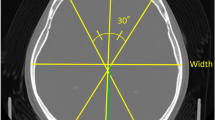Summary
To find evidence of cortical atrophy, 112 computer tomograms and 40 angiograms of patients above the age of 70 were evaluated. In the CT the width of the interhemispheric and of the sylvian fissure, in the angiograms the distance between the vessels extending into the interhemispheric fissure (anteroposterior view) and the distance between the cortical branches and the inner table (lateral view) were measured. The same measurements were performed in 100 normal computer tomograms and in 100 normal angiograms of patients between 20 and 40 years old. Statistically significant differences could be ascertained between the mean values for the patients over 70 and those for the younger ones, indicating that age-induced cerebral atrophy can be neuroradiologically demonstrated. The radiologic findings, however, do not necessarily correspond to the grade of intellectual impairment in the elderly. Neuropathologic and molecular biological research could bring us closer to the solution of this correlative problem.
Similar content being viewed by others
Literatur
Arendt, A.: Altern des Zentralnervensystems. In: Handbuch der allgemeinen Pathologie, Bd. VI/4, pp. 490–542 (eds. H. W. Altmann et al.). Berlin-Heidelberg-New York: Springer 1972
Bierny, J. P., Komar, N. N.: The sylvian cistern on computed tomography scanning. J. Comput. Ass. Tomogr. 1, 227–230 (1977)
Bronisch, F. W.: Die psychischen Störungen des älteren Menschen. Stuttgar: Ferdinand Enke 1962
Claveria, L. E., Moseley, I. F., Stevenson, J. F.: The clinical significance of cerebral atrophy as shown by C.A.T. In: Computerised axial tomography in clinical practice, pp. 213–217 (eds. G. H. du Boulay, I. F. Moseley). Berlin-Heidelberg-New York: Springer 1977
Haug, G.: Age and sex dependence of the size of normal ventricles on computed tomography. Neuroradiology 14, 201–204 (1977)
Haug, H.: Neuere Aspekte über den biologischen Alterungs-vorgang im menschlichen Gehirn. In: Verhandlungen der Anatomischen Gesellschaft, pp. 389–395 (eds. M. Watzka, H. Voss). Jena: Gustav Fischer 1975
Hempel, K. J.: Quantitative und topische Probleme der Alternsvorgänge im Gehirn. Verh. Dtsch. Ges. Pathol. 52 179–202 (1968)
Hoch-Ligeti, C.: Effect of aging on the central nervous system. J. Am. Geriatr. Soc. 11, 403–408 (1963)
Huang, Y. P., Wolf, B. S.: Angiographic features of the pericallosal cistern. Radiology 82, 14–23 (1964)
Lim, S. T., Sage, D. J.: Detection of subarachnoid blood clot and other thin, flat structures by computed tomography. Radiology 123, 79–84 (1977)
Lin, J. P., Kricheff, I. I.: Normal anterior cerebral artery complex; abnormal anterior cerebral artery. In: Radiology of the skull and brain, II/2, pp. 1391–1410; 1421–1441 (eds. T. H. Newton, D. G. Potts). St. Louis: C. V. Mosby 1974
McMenemey, W. H.: The aging brain. In: Pathology of the nervous system, II, pp. 1372–1379 (eds. J. Minckler). New York: McGraw-Hill 1971
Ries, W.: Physiologie des Alterns. In: Handbuch der allgemeinen Pathologie, Bd. VI/4, 150–244 (ed.: H. -W. Altmann et al.). Berlin-Heidelberg-New York: Springer 1972
Roberts, M. A., Caird, F. I.: Computerised tomography and intellectual impairment in the elderly. J. Neurol. Neurosurg. Psychiatry 39, 986–989 (1976)
Salamon, G., Huang, Y. P.: Radiologic anatomy of the brain. Berlin-Heidelberg-New York: Springer 1976
Schulte, W.: Moglichkeiten der Entfaltung und Gestaltung im Altern. Nervenarzt 29, 97–103 (1958)
Seitelberger, F.: Allgemeine Neuropathologie der Alternsund Aufbrauchkrankheiten des Gehirns. Verh. Dtsch. Ges. Pathol. 52, 32–61 (1968)
Strehler, B. L.: Molecular and systemic aspects of brain aging: psychobiology of informational redundancy. In: Aging, III, pp. 281–311 (eds. R. D. Terry, S. Gershon). New York: Raven Press 1976
Tomlinson, B. E., Blessed, G., Roth, M.: Observations on the brains of non-demented old people. J. Neurol. Sci. 7, 331–356 (1968)
Weitbrecht, H. J.: Psychiatrische Fehldiagnosen in der Allgemeinpraxis. Stuttgart: Georg Thieme 1966
Author information
Authors and Affiliations
Rights and permissions
About this article
Cite this article
Schindler, E., Ludwig, B. Beitrag zur Diagnose der Rindenatrophie: Auswertung von Computertomogrammen und Angiogrammen über 70 Jahre alter Patienten. Neuroradiology 16, 183–186 (1978). https://doi.org/10.1007/BF00395245
Issue Date:
DOI: https://doi.org/10.1007/BF00395245




